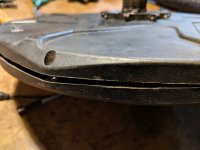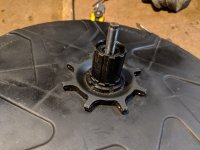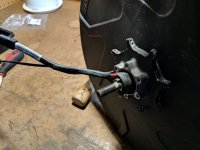liveforphysics said:https://wk.baidu.com/view/a3647f25aaea998fcc220eba?pcf=2#2
That steel would help its design work substantially better, but still a crutch.
Luke you have had right in terms of that.
It seems Bionx made some compromises on the D-motor. As they were using 0.35mm lams, they had to reduce the air gap flux density on purpose to keep iron losses on a normal level.
I did some research about magnetic designes and noticed follwing issues:
First:
The thickness of the back iron is insufficient.
If we assume the grade of the magnets is N35 (about 1,2T), the thickness should be 1/3 of the width of the magnets for optimal (close to 100%) steel return.
The D-motor magnets have a width of 7,6mm and the back iron is 1,6mm. If we do the math now (7,6mm / 3) it should be at least 2,5mm thick.
-> therefore the initial field strength of the magnets is already reduced!
Next thing is the effect of the airgap width in combination with the thickness of the magnets:
The flux density which reaches the stator teeth can be calculated like this:
thickness of magents / (thickness of magnets + air gap width)
so: 2mm / (2mm + 1mm) = 0,66%
-> this means the remaining field strenght, which is already lower due to the too thin back iron, will be reduced further to only 66%
If Bionx would have used thinner laminations of better or mentiond steel ($$$), they could have kept the air gap flux density on a MUCH higher level making it alot more torquey (probably up to twice as much?), and so much more interesting for hot-rodding.
Unfortunately, and as real world experince shows, it seems like it was just designed to be as cheap as possible for the torque target of 50Nm without any headroom.






